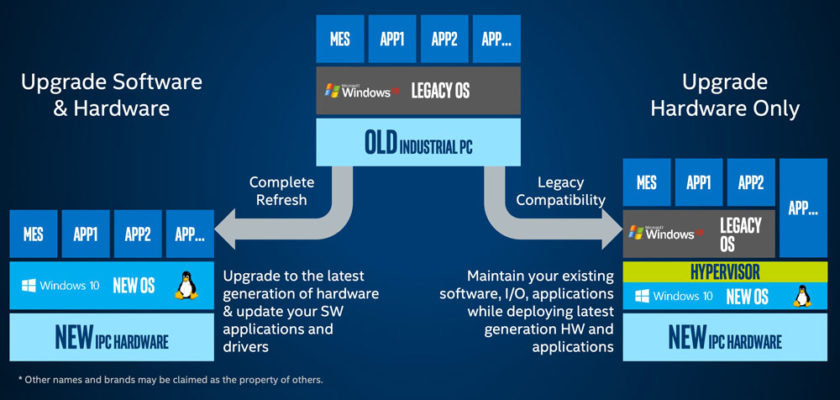The Path to Lights-Out Manufacturing Starts with Software

Manufacturers have a vision for lights-out manufacturing, where capabilities are defined by software rather than hardware. To get there, the factory floor will need to look more like an extension of the data center—and that means major changes for industrial PCs and the networks that connect them.
One of the biggest transitions will be the move away from dedicated, single-function machine controllers to generalized, multifunction hardware. “In the past you had these islands of automation—purpose-built equipment that only did one task,” said Jeff Hibbard, CEO of IntervalZero. “What you’re seeing now is the transformation to open systems that can be reused in different ways. But you don’t need to adjust your world, you just need to adjust the way you can perform your tasks.”
As the smart factory moves from fixed function to generalized systems, software offers the flexibility to dynamically take action on insights. “IT is going to control the PC up to the cloud, and OT will take it from the motherboard and the real-time piece. That is the convergence here that’s happening now,” said Hibbard.
Opening Up the Smart Factory
But how do we move to a modern industrial computing platform with the least disruption to manufacturing operations? Many options are available, including virtualization, containers, and even real-time extensions to Windows (Figure 1).

One approach to this migration is to start from scratch with a complete hardware and software refresh. And while this may result in a smaller software footprint, it takes time and effort to support legacy devices, drivers, and applications.
An alternative is to continue using your existing applications, OS, and so forth on the new hardware. This is possible through a hypervisor, a software layer that abstracts the hardware and allows existing code to run as if it were still on the old hardware.
And then there’s what may be the path of least resistance—a pre-integrated open platform that allows developers to focus solely on delivering their value-added applications. IntervalZero offers that route through APIs and a real-time kernel extension that sits on top of a multiprocessor platform (Figure 2).

“To put this idea in context, Android and iPhone platforms are excellent examples,” said Hibbard. “They provide all the necessary infrastructure and computing resources, integrate the components, and ensure both interoperability and stability. Application developers can concentrate on capturing their intellectual property in the application.”
The manufacturing path of least resistance? A pre-integrated open platform that allows developers to focus solely on delivering their value-added applications.
Linux vs. Windows
While many real-time systems are based on Linux, IntervalZero offers a different approach, offering real-time extensions to Windows. Basing a system on Windows has several advantages. For one, it gives developers, OEMs, and machine owners access to the myriad of vision systems, statistics packages, digital twins, and other industrial applications that run on Windows.
The broader Windows ecosystem is also a plus. It’s easy to find the developers, tools, and packages that go into making a smart factory. And from an IT perspective, a Windows-based IPC fits into their view of the factory as an extension of the server room.
“If I’m building a new machine, I can just take this package, put it on my machine, and make the machine run within hours because we have it all set up” explained Hibbard. “You get the benefit of having access to an ecosystem of Microsoft Windows powerful applications.”
The software automation platform provides the ability to customize a communication path to legacy equipment. “If you wanted to evolve, there’s a way to create components that you could then drag onto a pallet that includes older technology,” said Hibbard.
Smart Consolidation and Networking
Regardless of the approach, it’s important to think about how to reduce the total number of hardware platforms. That’s where the flexibility and power of Windows on the Intel® platform are a big advantage. “When you are only consolidating one machine, you can run on Intel Atom® chip,” said Hibbard. “But as you start adding more controllers to handle a whole line of machine workloads on one PC, now you need Intel® Core™. You can scale up your load as these machines take on more responsibility.”
“Another important factor is interconnectivity,” said Hibbard. “Networking is everything. To the outside world, where we need to have a secure, standard protocol such OPC UA for communicating in the cloud. But there’s a second network—with real-time communications on the factory floor that allows all of the controllers to talk to each other.”
Innovation in Action
In Japan, IntervalZero works with some of the world’s top surface-mount technology (SMT) companies, enabling them to continuously innovate and meet new market demands while protecting existing investments.
With quality and cost control a top priority, SMT manufacturers all built a motion control platform on Windows-based 64-bit industrial PCs. This enables them to leverage low hardware costs and take advantage of standard, commercial-off-the-shelf (COTS) communications.
The IntervalZero platform provides the ability to run a real-time OS on the same PC as their Windows IPC. And because the IntervalZero RTOS supports symmetric multiprocessing (SMP), manufacturers can add multiple components such as motion control, machine vision systems, software PLCs, and more functionality just by allocating more cores to the IntervalZero RTOS for deterministic execution.
This flexibility and extensibility allowed SMT builders to address new miniaturization and consolidation requirements, for example, by simply increasing the number of cores on the PC and allocating more cores to the IntervalZero RTOS.
Hibbard summed it up: “Our customers like the SMT manufacturers are able to evolve and thrive because their model is all software all of the time. What IntervalZero is doing is converting people to this software-driven model. That’s our vision and that’s what we’re working towards.”